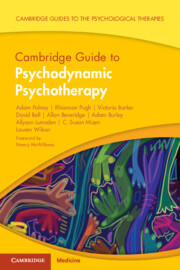
- Publisher:
- Cambridge University Press
- Online publication date:
- August 2023
- Print publication year:
- 2023
- Online ISBN:
- 9781009104425

A unique and accessible guide to contemporary psychodynamic therapy and its applications. Introduced with a foreword by Nancy McWilliams, an author line-up of experienced educators guide the reader through the breadth of psychodynamic concepts in a digestible and engaging way. The key applications of psychodynamic psychotherapy to a range of presentations are explored, including anxiety, depression, problematic narcissism as well as the dynamics of 'borderline' states. Specific chapters cover the dynamics of anger and aggression, and working with people experiencing homelessness. A valuable resource for novice and experienced therapists, presenting a clear, comprehensive review of contemporary psychodynamic theory and clinical practice. Highly relevant for general clinicians, third-sector staff and therapists alike, the authors also examine staff-client dynamics and the development of psychologically-informed services underpinned by reflective practice. Part of the Cambridge Guides to the Psychological Therapies series, offering all the latest scientifically rigorous, and practical information on a range of key, evidence-based psychological interventions for clinicians.
‘Unlike psychoanalytic authors whose writing is oriented mainly toward colleagues with extensive analytic training, these contributors intend their chapters to reach audiences that may be new to a psychoanalytic frame of reference, or sceptical of it, or confused by it. Somehow, they have also made the book interesting and clinically relevant to experienced psychoanalytic readers … I know from experience that it is not easy to produce a multi-authored compendium whose final product embodies an overall continuity and integration, and so I am impressed that the authors of this volume have managed that feat. I urge readers of all mental health disciplines, professional involvements, and theoretical orientations to spend time with this worthy and important book. I think you will find it as fascinating and clinically helpful as I did.’
Nancy McWilliams - Ph.D., Distinguished Retired Professor, Rutgers Graduate School of Applied & Professional Psychology
‘I thoroughly enjoyed reading this book and found it accessible and informative. The various authors conveyed the principles, practices, research, theories, and history of psychoanalysis in a way that was engaging and easy to understand, even for those such as myself, from outside the field. For clinicians (specialists and generalists alike) understanding the unconscious processes taking place in the consulting room can be invaluable in delivering effective care to our patients, and this book was able to provide insights into this important area.’
Dame Clare Gerada - President, Royal College of General Practitioners (RCGP), PRCGP FRCPsych FRCP (Hons)
‘This excellent book does exactly what it says it will; to be a guide to what psychodynamic psychotherapy is, how to do it well and for whom it works best. For too long, psychodynamic psychotherapy has been plagued by what we now might call ‘deep fakes’; first, that the idea that psychological therapists who think this way holds strange and esoteric sets of beliefs about how the mind works, and second, that there is no evidence that treatments based on this paradigm might be helpful. This helpful book outlines why both ideas have been conclusively proved wrong. I have no doubt that the future of psychiatry needs to be psychodynamic, and this book shows why psychodynamic thinking applied to psychiatry not only makes it more interesting, but makes us as psychiatrists more human and more effective.’
Gwen Adshead - Consultant forensic psychiatrist and psychotherapist, Broadmoor Hospital, Berkshire
‘The book demonstrates the ways in which psychodynamic psychotherapy can be applied with different diagnostic conditions. It describes important techniques and explains their use in clinical examples. Readers will not be disappointed with this wonderful publication.’
Gary B. Kaniuk Source: Doody's Reviews
‘It is a daunting task to undertake an intensive guide to the whole history and practice of psychodynamic psychotherapy. It is to the great credit of the authors and editors involved in the creation of this book that this has been carried out to such a high standard. It is not a textbook, despite being a comprehensive account of the field. It is not didactic or prescriptive enough for that, despite the clarity of presentation. The reader is introduced to the ambiguities and contradictions inherent in the work in a readable way, with many illuminating case histories and anecdotes. The comprehensive references and cross-referencing throughout the book provide the reader with opportunities to explore particular issues further should they wish to … I found this book to be a clear, thoughtful text which sets out the methods and scope of the general psychodynamic principles that underpin psychotherapy in all settings. I therefore recommend it to you.’
Sandra Grant Source: International Journal of Forensic Psychotherapy
 Loading metrics...
Loading metrics...
* Views captured on Cambridge Core between #date#. This data will be updated every 24 hours.
Usage data cannot currently be displayed.